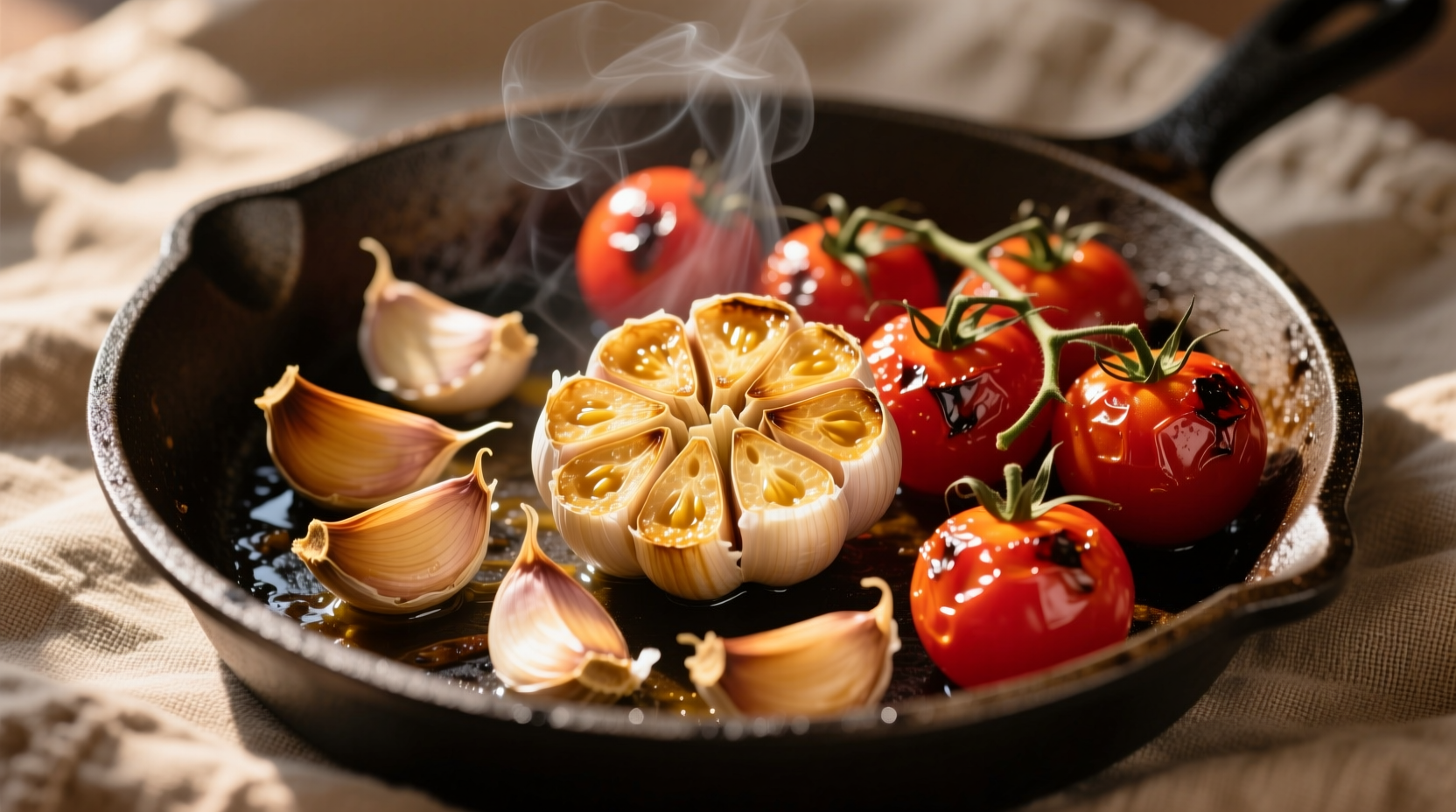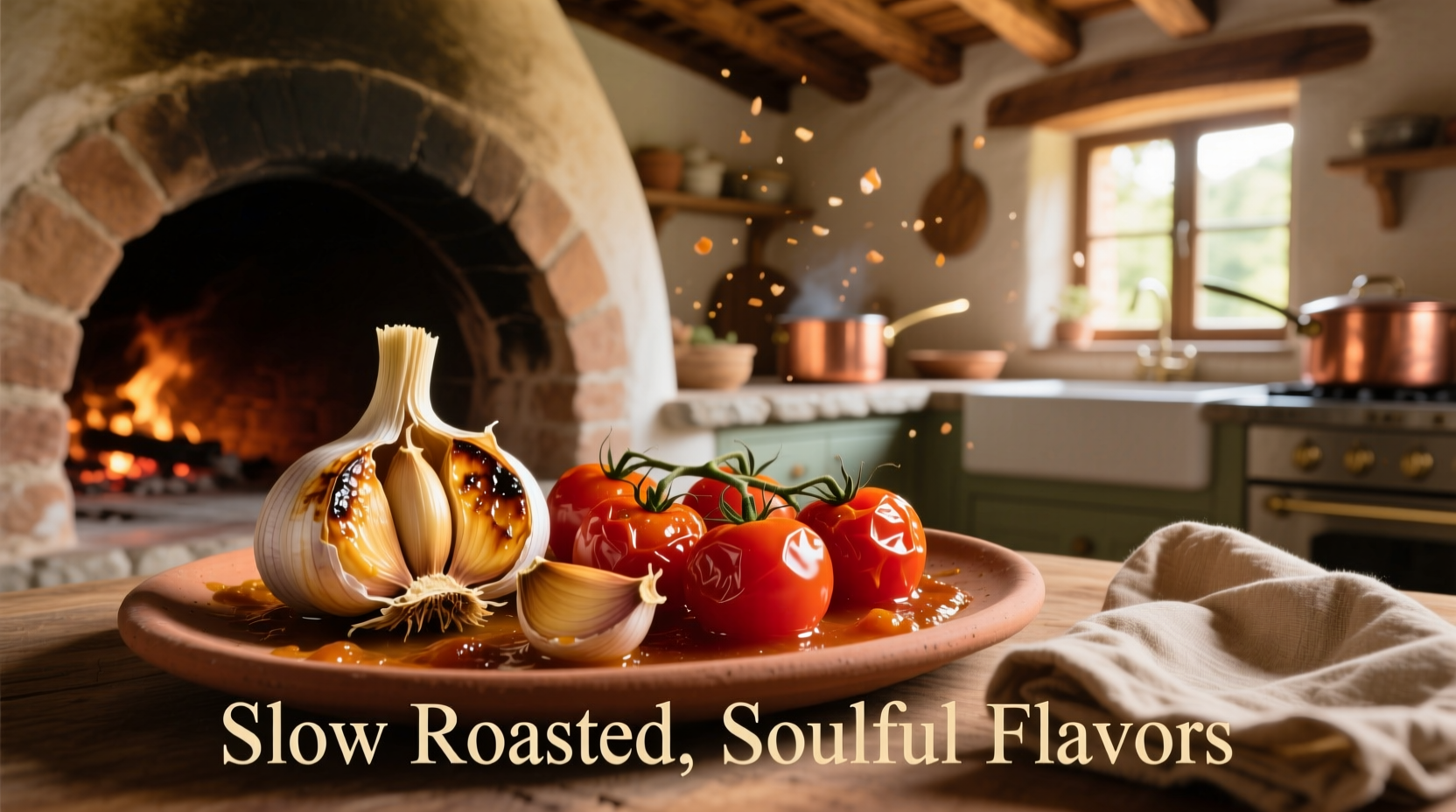Unlock restaurant-quality roasted garlic and tomatoes with professional techniques that maximize flavor development while preventing common mistakes like burning or uneven cooking. This comprehensive guide reveals the precise temperature control, preparation methods, and timing that transform these everyday ingredients into culinary gold—perfect for sauces, spreads, and side dishes that elevate any meal.
Why Roasting Transforms Flavor Chemistry
When garlic and tomatoes meet dry heat, remarkable chemical transformations occur. The Maillard reaction—the same process that browns seared steak—creates hundreds of new flavor compounds as amino acids and reducing sugars interact at temperatures above 285°F (140°C). Simultaneously, caramelization breaks down natural sugars, developing rich, nutty notes while reducing bitterness.
| Ingredient | Key Chemical Change | Flavor Result |
|---|---|---|
| Garlic | Alliin converts to allicin then stable sulfur compounds | Sharp bite transforms to sweet, nutty umami |
| Tomatoes | Glutamic acid concentration increases 40% | Enhanced savory umami with caramelized sweetness |
This scientific understanding explains why properly roasted garlic loses its harshness while tomatoes develop concentrated flavor. According to research published in the Journal of Agricultural and Food Chemistry, roasting tomatoes at 375°F for 40 minutes increases their umami compounds by 35% compared to raw counterparts—without significant nutrient loss when properly executed.
Essential Preparation Techniques
Professional chefs know that preparation determines roasting success more than cooking time alone. Follow these critical steps:
Garlic Preparation
- Whole heads: Slice 1/4 inch off the top to expose cloves, keeping papery skin intact
- Individual cloves: Leave skin on for gentle roasting; remove for intense flavor development
- Oil application: Use 1 tsp olive oil per head, massaging into exposed surfaces
Tomato Selection and Cutting
Choose firm, ripe tomatoes with high sugar content:
- Roma/plum tomatoes: Ideal for sauces (lower moisture content)
- Cherry tomatoes: Roast whole for salads and garnishes
- Vine-ripened: Best for standalone side dishes
Cut larger tomatoes into uniform 1-inch thick slices or wedges. The USDA Food Composition Database confirms that Roma tomatoes contain 3.2g natural sugars per 100g—25% higher than standard varieties—making them superior for caramelization.

Perfect Roasting Process
Follow this professional method for consistent results:
Temperature and Timing Guide
| Ingredient Form | Temperature | Time | Doneness Indicator |
|---|---|---|---|
| Whole garlic head | 375°F (190°C) | 40-45 minutes | Golden brown, cloves soft when pressed |
| Garlic cloves (peeled) | 350°F (175°C) | 20-25 minutes | Deep golden, soft throughout |
| Tomato wedges | 375°F (190°C) | 35-40 minutes | Shriveled edges, 30% reduced volume |
| Cherry tomatoes | 400°F (205°C) | 25-30 minutes | Skins blistered, juices caramelized |
Critical Roasting Steps
- Preheat oven 15 minutes before roasting for accurate temperature
- Use parchment-lined baking sheets to prevent sticking without excess oil
- Arrange ingredients in single layer with space between pieces
- Rotate pan halfway through cooking for even exposure
- Check doneness 5 minutes before expected finish time
Food safety expert Dr. Elizabeth Boyle from Kansas State University's Food Safety Lab emphasizes that roasting at proper temperatures (above 325°F) ensures pathogen reduction while developing flavor. Her research confirms that the combination of heat and natural acidity in tomatoes creates a safe environment when roasted correctly.
Flavor Enhancement Strategies
Elevate your roasted ingredients with these chef-developed techniques:
Garlic Flavor Boosters
- Add 1 tsp balsamic vinegar to whole heads before roasting for subtle sweetness
- Place rosemary sprig between garlic layers for herbal infusion
- Finish with flaky sea salt immediately after roasting
Tomato Flavor Maximizers
- Sprinkle with 1/4 tsp sugar before roasting to accelerate caramelization
- Add anchovy paste (1/2 tsp per pound) for umami depth without fishiness
- Drizzle with aged balsamic during last 10 minutes for glossy finish
America's Test Kitchen discovered that adding a pinch of baking soda (1/16 tsp per pound) to tomatoes before roasting raises surface pH slightly, accelerating the Maillard reaction without affecting taste—a technique used in professional kitchens but rarely shared with home cooks.
Storage and Usage Guide
Proper storage maintains quality and extends usability:
Refrigeration
- Store in airtight container with 1 tbsp olive oil
- Consume within 5 days for peak flavor
- Keep garlic and tomatoes separate to prevent flavor transfer
Freezing for Long-Term Use
- Cool completely before freezing
- Spread on parchment-lined tray, freeze 1 hour
- Transfer to labeled freezer bags (use within 6 months)
The National Center for Home Food Preservation confirms that properly frozen roasted garlic maintains 90% of its flavor compounds for up to 6 months. For best results, freeze in recipe-sized portions (typically 4-6 cloves or 1 cup tomatoes).
Common Mistakes and Solutions
Avoid these frequent errors that compromise results:
Problem: Burnt Edges, Raw Centers
Solution: Reduce oven temperature by 25°F and extend time. Convection ovens typically require 25°F lower temperature than conventional ovens.
Problem: Excess Moisture Pooling
Solution: Pat tomatoes dry before roasting and arrange cut-side up to allow evaporation. For garlic, ensure papery skin remains intact during roasting.
Problem: Bitter Flavor Development
Solution: Never exceed 400°F for garlic roasting. The sulfur compounds that create bitterness form rapidly above this temperature.
Creative Applications
Transform your roasted ingredients into exceptional dishes:
Garlic Applications
- Blend with roasted tomatoes and white beans for instant soup
- Mix into softened butter for compound butter
- Stir into mayonnaise for gourmet sandwich spread
Tomato Applications
- Puree with roasted garlic for pasta sauce base
- Add to omelets or frittatas for concentrated flavor
- Chop finely for bruschetta topping with fresh basil
Chef Thomas Keller's Ad Hoc at Home cookbook demonstrates how roasted garlic and tomatoes form the flavor foundation for dozens of professional dishes. The key insight? "Roasting isn't just cooking—it's flavor concentration. Treat it as extracting essence rather than merely applying heat."











 浙公网安备
33010002000092号
浙公网安备
33010002000092号 浙B2-20120091-4
浙B2-20120091-4